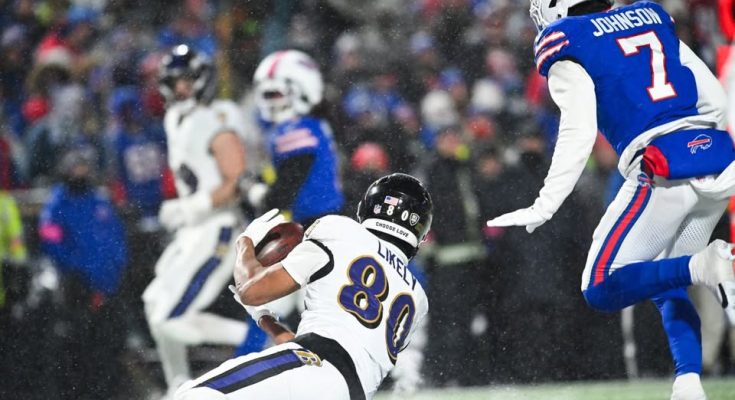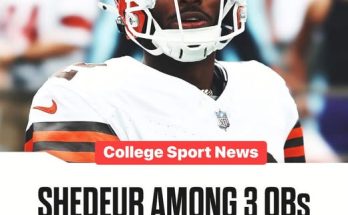░B░R░E░A░K░I░N░G░ ░N░E░W░S░ Baltimore Ravens Face Crucial 2026 NFL Offseason with 36 Players Set to Hit Free Agency
The Baltimore Ravens are heading into one of the most defining offseasons in franchise history, and the stakes couldn’t be higher. With 36 players set to hit free agency in 2026, the front office is bracing for a winter of difficult decisions, strategic restructuring, and the urgent need to preserve the core of a team that has been on the cusp of greatness for the past several seasons.
The Ravens have long prided themselves on smart roster construction, savvy cap management, and internal player development. However, even the best-run organizations hit a crossroads. The 2026 offseason marks that moment for Baltimore—a time when the future identity of the team will be shaped not just by who they sign, but by who they let go.
Among the 36 players with contracts expiring are key contributors on both sides of the ball, including starters, depth pieces, and veteran leaders who have helped mold the culture in the locker room. The sheer volume of players entering free agency puts the Ravens in a delicate position where one wrong move could disrupt years of progress and championship-caliber building.
At the top of the list is All-Pro cornerback Marlon Humphrey. The veteran defensive back has been the anchor of the secondary for years and remains one of the most physical, versatile cornerbacks in the NFL. Although Humphrey will be 30 when free agency begins, his skill set and leadership remain invaluable. Losing him would create a vacuum not only in terms of coverage ability but also in defensive communication and presence. The Ravens will have to weigh his age and injury history against his elite production and locker-room impact.
Next on the radar is inside linebacker Patrick Queen. After being drafted in the first round in 2020, Queen’s career took off, especially in the last two seasons where he formed a devastating tandem with Roquan Smith. But with Smith already under a massive deal and the linebacker market exploding, keeping Queen could require a contract north of $18 million per year. The Ravens must decide whether duplicating that level of investment at the position is sustainable within their overall salary cap structure.
On the offensive side, wide receiver Rashod Bateman is approaching the end of his rookie deal. While injuries slowed his early development, Bateman has flashed WR1 potential when healthy. In 2025, he delivered the most consistent campaign of his career, showing chemistry with Lamar Jackson and an ability to stretch the field. The Ravens, still searching for long-term answers at wide receiver, now face a conundrum: extend Bateman at his current value, or let him test a free-agent market that could price them out.
Speaking of Jackson, while the former MVP is under contract through 2027, the franchise’s long-term future hinges on putting the right pieces around him. That includes offensive linemen, and here lies another problem. Both starting guards—Kevin Zeitler and Ben Cleveland—are on expiring deals, as is center Tyler Linderbaum. Linderbaum, a former first-round pick, has become a cornerstone of the line, and it’s almost certain Baltimore will work to extend him. But doing so while also replacing or re-signing other linemen will be a logistical and financial challenge.
Defensively, other names looming in free agency include edge rushers Odafe Oweh and Jadeveon Clowney, safety Geno Stone, and defensive tackle Justin Madubuike. Oweh has grown into a productive pass rusher and is just hitting his stride, while Clowney provided veteran leadership and pressure consistency last season. Madubuike is one of the biggest priorities, coming off a breakout year in which he recorded double-digit sacks and became one of the top interior disruptors in the AFC.
And then there’s the special teams unit—something that often flies under the radar but has been a trademark of Baltimore’s success. Longtime kicker Justin Tucker, while still reliable, is aging. Though not yet in contract jeopardy, the Ravens will have to begin succession planning. Meanwhile, punter Jordan Stout and return specialist Devin Duvernay are among the names potentially heading for free agency. Replacing core special teams players is no small feat, especially in a system that has relied on field position and efficiency for years.
Behind all of this is General Manager Eric DeCosta, who has proven capable of threading the needle with difficult roster decisions. But even he is facing what could be his most difficult offseason to date. Cap space will be tight. Rookie contracts are maturing. The veteran nucleus is aging. And the expectation to contend remains unchanged. Fans, players, and analysts alike know the Ravens don’t rebuild—they reload. But reloading requires precision, not just good intentions.
Baltimore has long relied on hitting in the draft, but that formula only works if the picks pan out and those players can be retained or replaced affordably. With 36 potential free agents, the margin for error is razor-thin. The front office will need to prioritize which players are irreplaceable and which roles can be filled by younger, cheaper talent.
Some signs of strategy are already evident. The Ravens have been aggressive in restructuring deals to create cap flexibility, and multiple rookies from the past two draft classes are expected to take on bigger roles. Zay Flowers, for instance, is now the clear WR1 heading into 2026. On defense, young contributors like Trenton Simpson and Kyle Hamilton are expected to lead. Still, potential won’t fill the void left by departing veterans unless they develop quickly and consistently.
Another complicating factor is the free-agent market itself. With several other teams—like the Chargers, Cowboys, and Dolphins—also facing offseason overhauls, competition for quality players will be fierce. Even players who might prefer to stay in Baltimore could be lured away by massive offers or more prominent roles elsewhere.
Team chemistry and continuity will also be tested. Over the last few seasons, the Ravens have built a team that, on paper and in practice, was balanced, motivated, and closely bonded. Losing so many players in one cycle risks shaking that foundation. Leadership in the locker room will have to step up, particularly from returning stars like Lamar Jackson, Roquan Smith, and Mark Andrews.
There’s also the matter of perception. The Ravens have long been viewed as one of the league’s most stable franchises, with a clear culture of accountability and success. A chaotic offseason or a mass exodus of talent could disrupt that reputation and raise questions about the long-term direction of the organization.
What can fans expect? Likely a mix of re-signings, surprise cuts, and bargain free-agent additions. The Ravens have consistently found value where others didn’t—whether that’s mid-round picks turning into starters or veteran free agents rejuvenating their careers in Baltimore. That formula will be needed now more than ever.
The NFL is a league built on change, and 2026 will test the Ravens’ ability to manage it. For a team that has contended consistently without falling into complete rebuild mode, this offseason will be the ultimate stress test. Not just of the front office, but of the entire organizational philosophy.
With 36 players potentially heading out the door, the choices made in the next eight months will shape the Ravens for the next five years. Will they keep the core intact and take another shot at a title with Lamar Jackson leading the charge? Or will they enter a quieter, more transitional phase while trying to retool on the fly?
One thing is certain—change is coming. And in Baltimore, how the franchise responds to this moment will either cement their status as perennial contenders or signal the beginning of a new, uncertain chapter.
The countdown has begun.



